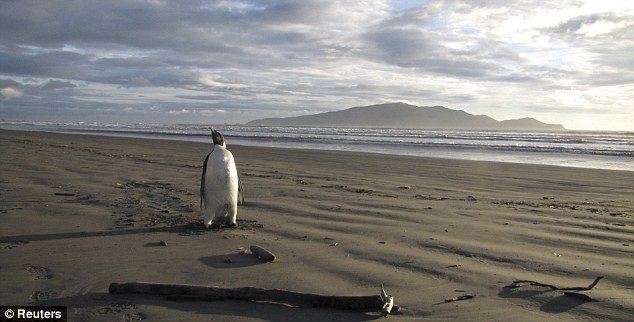Happy Feet, the world’s most famous penguin, who was rescued in a costly mission that restored him to his ocean home, may have ended up as a predator’s lunch.
Happy Feet, the wandering emperor penguin had been nursed back to health after being found on Peka Peka Beach in New Zealand – 3,000 miles north of its native Antarctica – in a very serious condition, after eating sand he thought was snow.
A human surgeon helped the vets in removing sticks and stones from Happy Feet‘ stomach.

The emperor penguin then had a GPS transmitter attached to him so his progress back into Antarctic waters could be tracked when he was released back into the ocean two weeks ago.
It appears the GPS transmitter attached to Happy Feet stopped working last Friday – about half way to his destination in the Southern Ocean.
Specialists said there are two possibilities: one, the device fell off and is sitting at the bottom of the ocean while Happy Feet continues safely on his journey or, the worst, they fear he could also be eaten in the jaws of a predator.
Emperor penguins have a number of predators including sharks, seals and killer whales.
In an early statement, Sirtrack, the company that attached the transmitter, told the New Zealand Herald that the lack of signal “leads to the conclusion that either the satellite transmitter has detached or an unknown event has prevented Happy Feet from resurfacing”.
A Sirtrack spokesman, Kevin Lay said there was “a chance” Happy Feet had been eaten, adding: “That’s what makes the world go round.”
Lay also said that the transmitter appeared to be in good working order up to the time it stopped sending data and the most likely explanation for the silence is that it had fallen off.
“The transmitter had been only glued on so that it would fall off in time.
“We hoped it would stay on for five or six months, but it appears in this case it’s only stayed on for two weeks.”
Lay added that it was possible that Happy Feet had been eaten, but he was doubtful.
“There are some species that will forage on emperor penguins but it’s not likely that it has happened to Happy Feet because of the area he was in,” he told New Zealand’s ONE News.
“We firmly believe that the transmitter has become detached.”
The spokesman said another possibility was that Happy Feet was underwater when the satellites that picked up the GPS signals were overhead.
“Maybe he’s just spending a lot of time under water because he’s found a good source of food,” said Kevin Lay.

Vets at the Wellington Zoo and experts who have been tracking the penguin’s progress all agreed that the next few days were critical.
Happy Feet was named after the 2006 animated feature about a tap-dancing emperor chick.
The penguin underwent four surgeries at Wellington Zoo to remove sticks and stones from his stomach and then spent two months in rehabilitation before being released into the ocean, well short of his habitat.

An international treaty prevents authorities from returning the penguin directly to Antarctica, so Happy Feet was released in an area where other juvenile emperor penguins like himself are at play at this time of the year.
When Happy Feet had finally been given a clean bill of health, he was placed in a specially-designed crate filled with ice and loaded onto the research vessel Tangaroa.
Sea conditions were too rough for Happy Feet to be released by hand, so he was placed on a tarpaulin slide running from the boat’s ramp.
[youtube 7atQ_MzXwU0]
